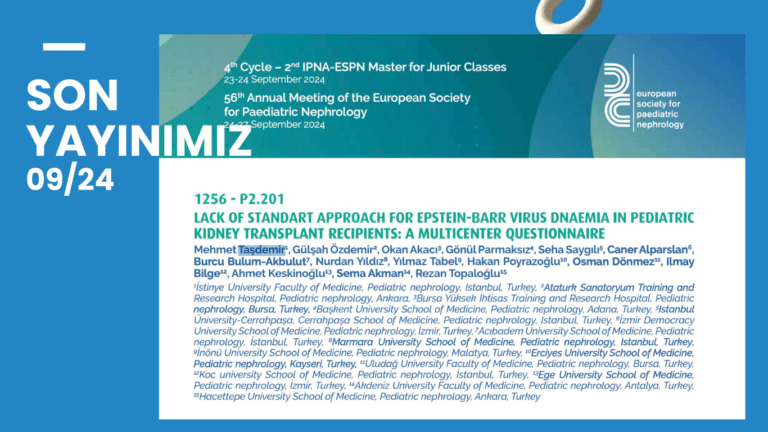
(Our study presented at the 56th European Society of Pediatric Nephrology Congress)
Çocuk böbrek nakilli hastalarda Epstein-Barr virüs önemli enfeksiyon ajanlarından ve nakil sonrası lenfoma dahil bir çok soruna yol açabilmekte. Bu konuda standart bir yaklaşım bulunmamasına dikkat çektiğimiz bildirimiz İspanya, Valencia’da düzenlenen 56. Avrupa Çocuk Nefroloji Birliği kongresinde sunulmak üzere kabul edildi ve yayınlandı.
EN
Epstein-Barr virus is an important infectious agent in patients with kidney transplantation and can cause many problems including lymphoma after transplantation. Our report, in which we draw attention to the lack of a standard approach on this issue, was accepted and published to be presented at the 56th European Society of Pediatric Nephrology Congress held in Valencia, Spain.
Abstract:
Aims/Purpose: In pediatric kidney transplant recipients (pKTR), Epstein-Barr virus (EBV) is often
seronegative, while donors are mostly seropositive. Therefore, EBV DNAemia is more common in
pediatric recipients compared to adults. This condition can lead to various significant issues including
post-transplant lymphoproliferative disorder. There are significant variations in the definition of EBV
DNAemia, testing methods, accepted threshold values, and patient management among centers.
This study aims to elucidate this situation.
Methods: This survey involved 17 pediatric nephrology centers in Turkey. The survey questions were
shared online with the centers, and responses were evaluated using the same system.
Results: A total of 39 pediatric nephrologist participated in the survey, including 12 consultants, 8
associate professors, and 19 professors. Kidney transplantation was performed in 83.3% of the centers.
All centers reported routine screening for EBV post-transplantation. However, the timing of the first
screening varied: one week (11.8%), one month (70.6%), and three months (5.9%), with two centers
(11.8%) not performing routine screening. Polymerase chain reaction (PCR) and serological methods
were used for testing, with percentages of 87.5% and 17.6%, respectively. The unit for EBV-DNA test
results was predominantly reported as copies/mL (87.5%) and IU/mL (12.5%), with significant variation
in the accepted threshold values, ranging from 50-1000 copies/mL to 10-4500 IU/mL. Follow-up
frequency in the presence of EBV DNAemia was predominantly every two weeks (82.4%), followed
by weekly (11.8%) and every three weeks (5.9%). Changes in immunosuppression were mainly made
by reducing the dose of mycophenolic acid (94.1%), followed by reducing tacrolimus dose (52.9%)
and steroid discontinuation (17.6%). Despite the reduction in immunosuppression, 88.2% of centers
preferred intravenous immunoglobulin, and 29.4% chose rituximab in cases of persistent EBV
DNAemia. Regarding the administration of rituximab, 53.9% of the centers reported no specific criteria,
while 23.5% preferred rituximab at 3 months and 11.8% at 2 months of persistent EBV DNAemia.
Conclusions: While there were various recommendations for patient monitoring and management
(especially regarding immunosuppressive changes, IVIG, and rituximab use) in the presence of EBV
DNAemia in pKTR, there is a need for a best clinical practice recommendation.
